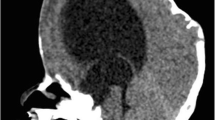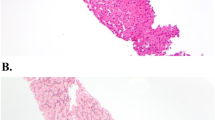Abstract
Introduction
Malfunction of cerebrospinal shunts is common and is due to multiple etiologies ranging from obstruction due to infiltrated brain tissue to mechanical disconnection.
Discussion
We review the differential diagnosis and recommended evaluation and treatment for cerebrospinal fluid (CSF) eosinophilia.
Illustrative case
We report a child who, following the use of an antibiotics-impregnated ventricular catheter, developed sterile ventriculoperitoneal shunt malfunction thought to be due to profound CSF eosinophilia. Following removal of the catheter, the eosinophilia spontaneously resolved, and at long-term follow up, the patient has a functioning non-antibiotic impregnated shunt catheter.
Conclusions
Patients presenting with signs of shunt malfunction but without signs of CSF infection and with a raised CSF eosinophilia should be suspicious for cellular obstruction of their shunt system, i.e., sterile shunt malfunction.
Similar content being viewed by others
References
Bell RS, Vo AH, Cooper PB, Schmitt CL, Rosner MK (2006) Eosinophilic meningitis after implantation of a rifampin and minocycline-impregnated ventriculostomy catheter in a child. Case report. J Neurosurg 104:50–54
Fulkerson D, Boaz J (2008) Cerebrospinal fluid eosinophilia in children with ventricular shunts. J Neurosurg Pediatr 1:288–295
Grabb PA, Albright AL (1992) Intraventricular vancomycin-induced cerebrospinal fluid eosinophilia: report of two patients. Neurosurgery 30:630–635
Hashimoto M, Yokota A, Urasaki E, Tsujigami S, Shimono M (2004) A case of abdominal CSF pseudocyst associated with silicone allergy. Childs Nerv Syst 20:761–764
Kennedy CR, Singer HS (1988) Eosinophilia of the cerebrospinal fluid: late reaction to a silastic shunt. Dev Med Child Neurol 30:386–390
Lo Re V III, Gluckman S (2003) Eosinophilic meningitis. Am J Med 114:217–223
Niggemann B, Bauer A, Jendroska K, Wahn U (1997) Latex allergy as a cause of eosinophilia in cerebrospinal fluid in a child with a ventricular shunt. J Allergy Clin Immunol 100:849–850
Nejat F, Yazdani S, Mahdavi A, Kazemi H, Habibi Z, Panahi GS, Poorpak Z (2007) Effect of shunt catheter on the systemic immune response: evaluation of neutrophil count, function, and rate of chemotaxis. J Neurosurg 106:288–291
Nutman T (2007) Evaluation and differential diagnosis of marked, persistent eosinophilia. Immuno Allergy Clin North Am 27:529–549
Pittman T, Willimas D, Rathore M, Knutsen AP, Mueller KR (1994) The role of ethylene oxide allergy in sterile shunt malfunctions. Br J Neurosurg 8:41–45
Snow RB, Kossovsky N (1989) Hypersensitivity reaction associated with sterile ventriculoperitoneal shunt malfunction. Surg Neurol 31:209–214
Tanaka T, Ikeuchi S, Yoshino K, Isoshima A, Abe T (1999) A case of cerebrospinal fluid eosinophilia associated with shunt malfunction. Pediatr Neurosurg 30:6–10
Traynelis VC, Powell RG, Koss W, Schochet SS, Kaufman HH (1988) Cerebrospinal fluid eosinophilia and sterile shunt malfunction. Neurosurgery 23:645–649
Tung H, Raffel C, McComb JG (1999) Ventricular cerebrospinal fluid eosinophilia in children with ventriculoperitoneal shunts. J Neurosurg 75:541–544
Tzvetanova EM, Tzekov CT (1986) Eosinophilia in the cerebrospinal fluid of children with shunts implanted for the treatment of internal hydrocephalus. Acta Cytol 30:277–280
Venes JL (1974) Pleural fluid effusion and eosinophilia following ventriculo-pleural shunting. Dev Med Child Neurol 16:72–76
Wiersbitzky SK, Ahrens N, Becker T, Panzig B, Abel J, Stenger RDA (1998) The diagnostic importance of eosinophil granulocytes in the CSF of children with ventricular-peritoneal shunt systems. Acta Neurol Scand 97:201–203
Author information
Authors and Affiliations
Corresponding author
Rights and permissions
About this article
Cite this article
Tubbs, R.S., Muhleman, M., Loukas, M. et al. Ventriculoperitoneal shunt malfunction from cerebrospinal fluid eosinophilia in children: case-based update. Childs Nerv Syst 28, 345–348 (2012). https://doi.org/10.1007/s00381-011-1530-x
Received:
Accepted:
Published:
Issue Date:
DOI: https://doi.org/10.1007/s00381-011-1530-x




